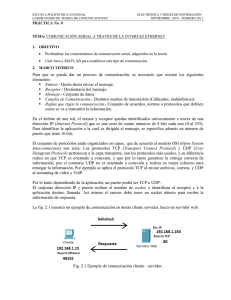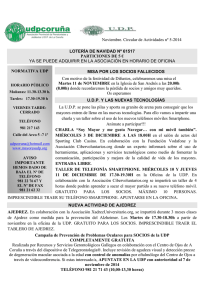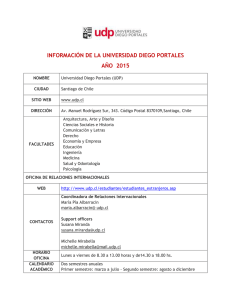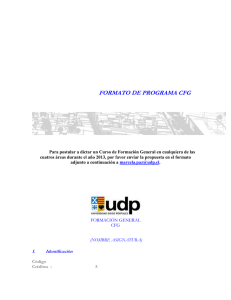Introducción a Ethernet
Anuncio
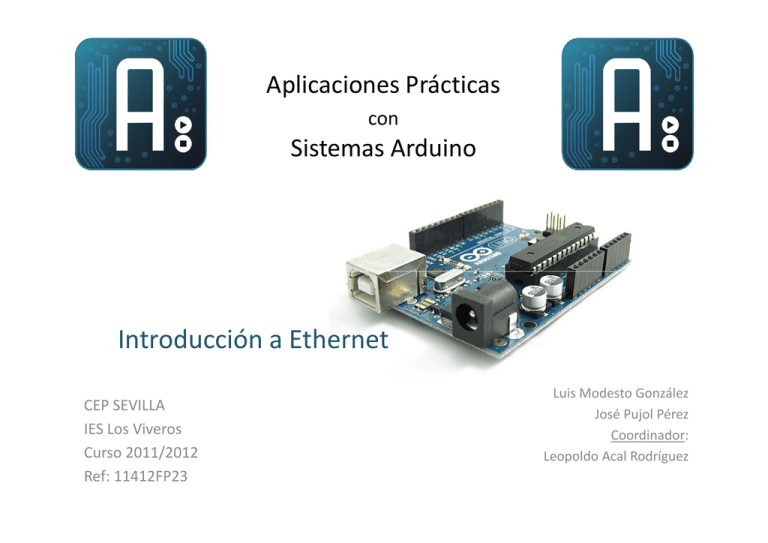
Aplicaciones Prácticas
con
Sistemas Arduino
Introducción a Ethernet
CEP SEVILLA
IES Los Viveros
Curso 2011/2012
Ref: 11412FP23
Luis Modesto González
José Pujol Pérez
Coordinador:
Leopoldo Acal Rodríguez
UDP
• Modelo Cliente - Servidor
• Para la comunicación UDP, necesitamos:
– Dirección MAC
– Dirección IP del origen y del destino
– Puerto de envío
Entorno ordenador
•Disponemos de:
• MAC
• IP origen
•Necesitamos asignar
• IP destino
• Puerto
Entorno Arduino
Disponemos de:
•Nada
Necesitamos asignar
•MAC
•IP origen (la nuestra)
•IP destino
•Puerto
1
Programación Visual C
•
•
•
•
Clase UdpClient
No es un componente visual
Documentación en http://msdn.microsoft.com/es-es/library/9wkb9k12.aspx
Métodos usados:
– BeginReceive: Inicia al “escuchador” Udp
– EndReceive: Finaliza la recepción de datos y recupera los
datos leidos
– Send: Permite enviar un mensaje Udp.
2
EJEMPLO 1: Encendido del led
• Necesitamos conocer la configuración IP de nuestra red, para
configurar arduino.
• Cargamos el ejemplo Ethernet->dhcpPrinter
• Ponemos como dirección MAC la que viene en la pegatina de
nuestra Ethernet Shield.
• Conectamos el cable de red y abrimos el monitor serie
• Si todo ha ido bien, obtendremos algo así.
• No podemos tener direcciones repetidas
3
EJEMPLO 1: Visual C
• Creamos el formulario con los nombres a los textBox en rojo
• Para encender el Led, enviaremos un 50 y para apagarlo un 51
• No podremos usar el led del Pin 13, porque ese pin lo usa el ethernet
shield. Colocaremos un led entre los pines 2 y 3.
4
EJEMPLO 1: Visual C
• Incluimos la librería <windows.h>
• Incluimos la sentencia (sólo si nuestro programa usará threads –hilos)
CheckForIllegalCrossThreadCalls=0;
• Añadimos los espacios de nombres para poder usar UdpClient, justo
debajo de las otras declaraciones de nombres
using
using
using
using
namespace
namespace
namespace
namespace
System::Net;
System::Net::Sockets;
System::Text;
System::Threading;
5
EJEMPLO 1: Visual C
• Función del botón encender
////////////////////encender led ///////////////////////////////
array<Byte>^ sendBytes = gcnew array<Byte> (10);
sendBytes[0]=50;
UdpClient^ cliente = gcnew UdpClient;
cliente->Send(sendBytes,1,
dirIp->Text,Int32::Parse(this->puerto->Text));
cliente->Close();
6
EJEMPLO 1: Visual C
• Función del botón apagar
////////////////////apagar led ///////////////////////////////
array<Byte>^ sendBytes = gcnew array<Byte> (10);
sendBytes[0]=51;
UdpClient^ cliente = gcnew UdpClient;
cliente->Send(sendBytes,1,
dirIp->Text,Int32::Parse(this->puerto->Text));
cliente->Close();
7
EJEMPLO 1: Visual C
• Antes de ejecutar, inicializamos los campos IP, y
puerto desde el constructor.
Form1(void)
{
InitializeComponent();
//
//TODO: agregar código de constructor aquí
//
this->dirIp->Text="192.168.1.21";
this->puerto->Text="1500";
}
8
EJEMPLO 1: Arduino
•
•
Cargamos el programa de arduino.
Ajustamos dirección Mac, dirección IP y puerto
#include <SPI.h>
// needed for Arduino versions later than 0018
#include <Ethernet.h>
#include <EthernetUdp.h>// UDP library from: [email protected] 12/30/2008
#define UDP_TX_PACKET_MAX_SIZE 64
// Enter a MAC address and IP address for your controller below.
// The IP address will be dependent on your local network:
byte mac[] = { 0xDE, 0xAD, 0xBE, 0xEF, 0xFE, 0xED };
byte ip[] = { 192,168,1,177 };
unsigned int localPort = 1500;
// local port to listen on
// buffers for receiving and sending data
char packetBuffer[UDP_TX_PACKET_MAX_SIZE]; //buffer to hold incoming packet,
EthernetUDP Udp;
void setup() {
pinMode(5,OUTPUT);
pinMode(7,OUTPUT);
digitalWrite(5,LOW); //Ponemos el pin 5 a 0 para conectar el led entre el 5 y el 7
digitalWrite(7,HIGH); //por defecto lo dejo encendido
// start the Ethernet and UDP:
Ethernet.begin(mac,ip); //si quitamos el parámetro ip, tomaremos una ip desde el dhcp
Udp.begin(localPort);
Serial.begin(9600);
}
9
EJEMPLO 1: Arduino
• Código del bucle principal
void loop() {
byte dato;
int packetSize = Udp.available(); // note that this includes the UDP header
Udp.parsePacket(); //Procesamos el paquete
//Si se reciben varios paquetes, se acumulan todos en el buffer, por eso, los vamos a
separar
while (packetSize>8)
{
Serial.print("Recibido paquete de tamaño ");
Serial.println(packetSize);
// read the packet into packetBufffer and get the senders IP addr and port number
Udp.read(packetBuffer,10);
dato=packetBuffer[0];
switch(dato)
{
case 50: digitalWrite(7,HIGH); break;
case 51: digitalWrite(7,LOW); break;
}
Serial.println("Contenido:");
Serial.println(dato,DEC);
Serial.print("Dir. IP ");
Serial.println(Udp.remoteIP());
Serial.print("Puerto ");
Serial.println(Udp.remotePort());
packetSize-=10;//restamos el tamaño de un paquete leido
}
Udp.flush();//vaciamos cualquier contenido que quede en el buffer UDP
delay(10);
}
10
EJEMPLO 2: Leer entrada digital
Interface
• Similar al anterior, pero ahora leeremos el valor de un entrada
digital.
• Usaremos un protocolo pregunta-respuesta, en la que el PC
solicita el estado del puerto y arduino contesta
• Usaremos un timer para fijar la frecuencia con que realizamos
las lecturas.
11
EJEMPLO 2: Visual C
Variables globales
• Nos basamos en el ejemplo anterior, para añadir
funcionalidades.
• Declaramos una variable global de tipo UdpClient
• Lo hacemos al principio del código
///
///
private
///
<summary>
Variable del diseñador requerida.
:UdpClient ^listener;
</summary>
12
EJEMPLO 2: Visual C
Iniciar servidor
• Botón Iniciar servidor
– Inicia al listener Udp en el puerto seleccionado.
– Asigna una función al evento de recibir datos
– Inicia el timer que controla la petición de datos
///////////////// boton iniciar servidor////////////
listener=gcnew UdpClient (Int32::Parse(this->puerto->Text));
Listener->BeginReceive(gcnew
AsyncCallback(this,&Form1::recibirUdp),listener);
timer1->Enabled=true;
///////////////// Tratamiento del evento de recibir datos ////////////
private: System::Void recibirUdp(IAsyncResult^ result) {
array<Byte>^ receivedBytes = gcnew array<Byte> (256);
UdpClient^ receptor = (UdpClient^ )result->AsyncState;
IPEndPoint^ RemoteIpEndPoint = gcnew IPEndPoint(0,Int32::Parse(this->puerto->Text) );
receivedBytes=receptor->EndReceive(result,RemoteIpEndPoint);//leemos los datos
listener->BeginReceive(gcnew AsyncCallback(this,&Form1::recibirUdp),listener); //reasignamos
//Tratamiento de los datos recibidos
}
13
EJEMPLO 2: Visual C
Timer
• Asignamos el evento del timer y lo ajustamos a
500ms
• El timer enviará un paquete con el código 52, para
solicitar la lectura del puerto 2
///////////////// Tratamiento del tick del timer////////////
array<Byte>^ sendBytes = gcnew array<Byte> (10);
sendBytes[0]=52;
UdpClient^ cliente = gcnew UdpClient;
cliente->Send(sendBytes,1,dirIp->Text,Int32::Parse(this->puerto->Text));
cliente->Close();
14
EJEMPLO 2: Visual C
Tratamiento datos recibidos
•
•
•
•
Arduino devolverá 2 bytes, código de función y estado
En nuestro caso, sólo hay un código de función que es el 52
Si el estado es 0, el color será negro, y si es 1 será verde lima
Esto lo colocaremos dentro de la función recibirUdp
///////Tratamiento de los datos recibidos
switch (receivedBytes[0]){
case 52: if(receivedBytes[1]==0)
this->entrada1->BackColor = System::Drawing::SystemColors::ActiveCaptionText;
else this->entrada1->BackColor = System::Drawing::Color::Lime;
break;
}
///
15
EJEMPLO 2: Visual C
• Al iniciar el servidor, debemos ver el puerto a la
escucha, ejecutando netstat -a, en una ventana de
msdos
16
EJEMPLO 2: Arduino
• El código será similar al ejemplo anterior
#include <SPI.h>
// needed for Arduino versions later than 018
#include <Ethernet.h>
#include <EthernetUdp.h> // UDP library from: [email protected] 12/30/2008
#define UDP_TX_PACKET_MAX_SIZE 64// Enter a MAC address and IP address for your control
ler below.// The IP address will be dependent on your local network:
byte mac[] = { 0xDE, 0xAD, 0xBE, 0xEF, 0xFE, 0xED };
byte ip[] = { 192,168,1,177 };
unsigned int localPort = 1500; // local port to listen on
char packetBuffer[UDP_TX_PACKET_MAX_SIZE]; //buffer to hold incoming packet,
byte ReplyBuffer[]="datos recibidos en arduino";//buffer de respuesta
EthernetUDP Udp;
void setup() {
pinMode(2,INPUT);
pinMode(5,OUTPUT);
pinMode(7,OUTPUT);
digitalWrite(5,LOW); //Ponemos el pin 5 a 0 para conectar el led entre el 5 y el 7
digitalWrite(7,HIGH); //por defecto lo dejo encendido
digitalWrite(2,HIGH);//activamos el pull-up del pin1
// start the Ethernet and UDP:
Ethernet.begin(mac,ip); //si quitamos ip, tomaremos una ip desde el dhcp
Udp.begin(localPort);
Serial.begin(9600);
}
17
EJEMPLO 2: Arduino
• El loop también será parecido
void loop() {
byte dato;
int packetSize = Udp.available(); // note that this includes the UDP header
Udp.parsePacket(); //Procesamos el paquete
//Si se reciben varios paquetes, se acumulan en el buffer, por eso, los vamos a separar
while (packetSize>8) {
Serial.print("Recibido paquete de tamaño ");
Serial.println(packetSize);
// read the packet into packetBufffer
Udp.read(packetBuffer,10);
dato=packetBuffer[0];
switch(dato)
{
case 50: digitalWrite(7,HIGH); break;
case 51: digitalWrite(7,LOW); break;
case 52: ReplyBuffer[0]=52;
ReplyBuffer[1]=digitalRead(2);//leo el pin 2
Udp.beginPacket(Udp.remoteIP(), localPort);
Udp.write( ReplyBuffer,2 );
Udp.endPacket();
break;
}
Serial.println("Contenido:"); Serial.println(dato,DEC);
Serial.print("Dir. IP ");
Serial.println(Udp.remoteIP());
Serial.print("Puerto ");
Serial.println(Udp.remotePort());
packetSize-=10;//restamos el tamaño de un paquete leido
}
Udp.flush();//vaciamos cualquier contenido que quede en el buffer UDP
18
delay(10);}
EJEMPLO 3: Descubrir arduinos
• Vamos a añadir al ejemplo anterior, un botón que permita descubrir
arduinos en nuestra red
• Para ello, implementaremos el comando 49, que lo dirigiremos a la
dirección IP 255.255.255.255, que corresponde al broadcast.
• En arduino, implementaremos una respuesta a este comando que
identifica a nuestro arduino con su IP y nuestro nombre
19
EJEMPLO 3: Visual C
Botón descubrir
• Envía un mensaje al broadcast con el código 49
////////////////////Descubrir arduinos ///////////////////////////////
array<Byte>^ sendBytes = gcnew array<Byte> (10);
sendBytes[0]=49;
UdpClient^ cliente = gcnew UdpClient;
cliente->Send(sendBytes,1,"255.255.255.255",Int32::Parse(this->puerto->Text)
cliente->Close();
20
EJEMPLO 3: Visual C
Tratamiento datos recibidos
• Arduino devolverá un mensaje con código 48.
• Mostramos en el textbox la cadena que contenga.
case 48:
textBox1->Text+=cadena[1]+"-"+cadena[2]+ "\r\n“;
break;
21
